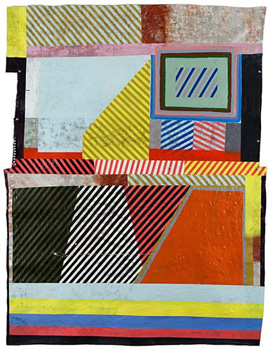
Continuing through October 1, 2011
To call Jeffrey Gibson a crossover artist is to misunderstand the place of indigenous art in the history of Modernism. Native art has always, it seems, laid claim to the application of abstraction, intense color ranges, and multiple levels of meaning. Since cultural interactions between Native people and Americans of European descent were, in the past, primarily geared toward commerce, we have tended to comprehend Native art as commercial in nature: a ceramic vessel; a finely woven rug of naturally dyed wool; or perhaps an artifact from the past such as a parfleche (made to hold arrows) of skin and beads, with stunning, albeit fading, geometric patterning painted onto the rawhide.
This means of understanding contemporary indigenous art is deceiving, however, and artists such as Gibson combat stereotypes about Native art at the same time they employ traditional compositional elements in their current work. Gibson and his colleagues across North America are not crossing over from “Indian” to “contemporary” art. Rather, they are using their cultural history as a springboard for artmaking, just as artists have done globally for hundreds of years. Generally, this kind of Native art has been neglected until the last decade or so, unless a big-name, non-Native artist along the lines of a Jackson Pollock claims to have been inspired, for example, by Navajo sand paintings. With such significant figures as Bob Haozous and Jaune Quick-To-See Smith making art these days, it’s well past time that we paid attention to indigenous artists for their own sakes — precisely as contemporary artists.
This brings us back to Gibson’s exhibition, “Trade.” The title, of course, references notions of the art that Native Americans made in order to barter — first with each other and later with Euro-Americans. Gibson successfully works these reference points into a dialog with modern and contemporary art. By washing some of his old painted canvases and using them to create collages that are stitched, glued, beaded, and studded together, Gibson references not only Native art but Peter Halley’s Neo-Geo works, Jasper Johns’s hatch mark paintings, and the brilliant colors and textural qualities of the pattern and decoration-based aesthetic. Gibson’s “Billboard” and a partner piece, “Blister in the Sun,” employ a “pony tail” of bead work, protruding from the re-worked and recycled canvas, to evoke the organic forms of post-minimalism, Abstract Expressionism’s drip paintings, as well as the street vernacular of construction-zone signage rendered with the look and feel of rawhide. His paintings are visceral and cerebral in their effect, making for a satisfying encounter between cultures as they are today. It’s no wonder, then, that Gibson was named by editor Evan Garza of New American Painting as one of “11 to Watch in 2011.”
